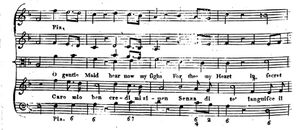Difference between revisions of "È morto il mio Gesù"
(Created page with "{{Short description|aria}}<!-- no repetition of page title--> <!-- if it is not a solitary work, here comes the infobox from the work containing it. E. g., not “Casta Diva...") |
|||
| Line 57: | Line 57: | ||
}} | }} | ||
'''"{{lang|it|È morto il mio Gesù}}"''' is an aria from the oratorio {{lang|it|Morte e sepoltura di Christo}} | '''"{{lang|it|È morto il mio Gesù}}"''' is an aria from the oratorio {{lang|it|Morte e sepoltura di Christo}} (engl.: Christ's Death and Burial) by [[Antonio Caldara]]. The libretto was created by [[Francesco Fozio]]; the work was first performed in Vienna in 1724.<ref name="Wiki"/> The role of Maria di Giacobbe was first created by [[Giovanni Carestini]]. | ||
=="Maria di Giacobbe"== | =="Maria di Giacobbe"== | ||
In the medieval ''Legenda aurea'', Cleophas is directly identified with Alphaeus, the father of Jacobus the Younger (Mt 10:28 EU), so that his wife Mary is regarded as the mother of Jacobus the Younger, Simon Zelotes and Judas Thaddeus. This identification is also held today by individual, mostly Catholic interpreters, who assume a sameness or alternation of names of one and the same person due to the similarity of the names, as it occurred more frequently with the Graecization of Jewish names (the assumption presumes a person with the seminitic name "Chalpai").''(Translated from German Wikipedia)''<ref name=" | In the medieval ''Legenda aurea'', Cleophas is directly identified with Alphaeus, the father of Jacobus the Younger (Mt 10:28 EU), so that his wife Mary is regarded as the mother of Jacobus the Younger, Simon Zelotes and Judas Thaddeus. This identification is also held today by individual, mostly Catholic interpreters, who assume a sameness or alternation of names of one and the same person due to the similarity of the names, as it occurred more frequently with the Graecization of Jewish names (the assumption presumes a person with the seminitic name "Chalpai").''(Translated from German Wikipedia)''<ref name="WikiK"/> | ||
It appears on the following album: | It appears on the following album: | ||
| Line 179: | Line 179: | ||
|quote=}} | |quote=}} | ||
</ref> | </ref> | ||
}} | <ref name="WikiK"> | ||
{{cite web | |||
|url=https://de.wikipedia.org/wiki/Maria_Kleophae | |||
|archive-url=https://web.archive.org/web/20211014230009/https://de.wikipedia.org/wiki/Maria_Kleophae | |||
|title=Maria Kleophae | |||
|last= | |||
|first= | |||
|date= | |||
|website=Wikipedia | |||
|publisher= | |||
|access-date={{date|2021-10-14|DMY}} | |||
|archive-date={{date|2021-10-14|DMY}} | |||
|quote=}} | |||
</ref> | |||
}} | }} | ||
[[Category:18th-century music]] | [[Category:18th-century music]] | ||
[[Category:sacred]]<!-- secular or sacred --> | [[Category:sacred]]<!-- secular or sacred --> | ||
Revision as of 01:00, 15 October 2021
"È morto il mio Gesù" is an aria from the oratorio Morte e sepoltura di Christo (engl.: Christ's Death and Burial) by Antonio Caldara. The libretto was created by Francesco Fozio; the work was first performed in Vienna in 1724.[1] The role of Maria di Giacobbe was first created by Giovanni Carestini.
"Maria di Giacobbe"
In the medieval Legenda aurea, Cleophas is directly identified with Alphaeus, the father of Jacobus the Younger (Mt 10:28 EU), so that his wife Mary is regarded as the mother of Jacobus the Younger, Simon Zelotes and Judas Thaddeus. This identification is also held today by individual, mostly Catholic interpreters, who assume a sameness or alternation of names of one and the same person due to the similarity of the names, as it occurred more frequently with the Graecization of Jewish names (the assumption presumes a person with the seminitic name "Chalpai").(Translated from German Wikipedia)[2]
It appears on the following album:
| Year | Album | Ensemble | Conductor |
|---|---|---|---|
Libretto
Manuscripts and sheet music

- Free Score at the IMSLP:
- Copyist of Vienna
- Manuscript, n.d.(ca.1724).
- Copyright: Public Domain
- Österreichische Nationalbibliothek, Vienna (A-Wn): Mus.Hs.17120
- Caldara, Antonio (1724). "Morte e sepoltura di Cristo". IMSLP. Archived from the original on 14 October 2021. Retrieved 14 October 2021.
References
- ↑ "Giuseppe Porsile". Wikipedia. Archived from the original on 14 October 2021. Retrieved 14 October 2021.
- ↑ "Maria Kleophae". Wikipedia. Archived from the original on 14 October 2021. Retrieved 14 October 2021.
- ↑ Caldara, Antonio (1724). "Morte e sepoltura di Cristo". IMSLP. Archived from the original on 14 October 2021. Retrieved 14 October 2021.
<ref> tag with name "EClassical" defined in <references> is not used in prior text.